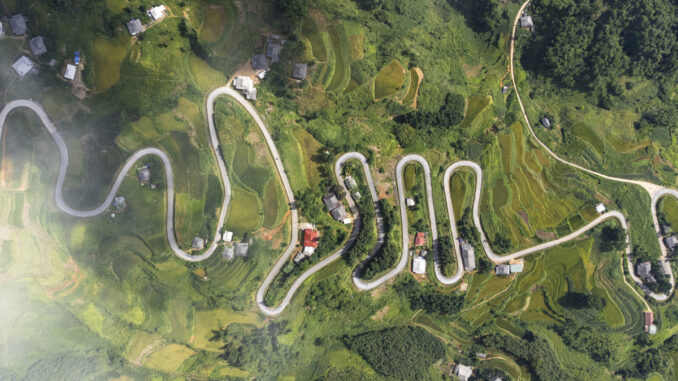
CAO BANG – Located on the same road as the famous 15-storey Khau Coc Cha Pass, Na Tenh Pass has 20 gentle bends and romantic scenery but is not known to many people.

Cao Bang is a province with many beautiful passes in Vietnam, such as the 15-storey Khau Coc Cha pass and the 7-storey Ma Phuc pass. Among the passes in Cao Bang, Na Tenh pass with 20 bends is less mentioned.
On the road from Ha Giang to Cao Bang, about 15 km past Khau Coc Cha pass is Na Tenh pass. Na Tenh Pass is located in Can Nong commune, Ha Quang district, bordering Xuan Truong commune, Bao Lac district, Cao Bang province.

When planning a trip to Cao Bang by motorbike at the end of September, Mr. Le Thanh Binh (29 years old, Hanoi) accidentally saw an image of Na Tenh Pass on the directions app.
Seeing that the pass is winding and winding with many beautiful turns, yet unknown to many backpackers, he decided to put the pass on the list of destinations during the trip.

Different from the overwhelming feeling of Khau Coc Tra Pass with 15 levels of vertical passes like stairs on high-slope cliffs, Na Tenh Pass has a gentler slope and curves softly like a strip of silk.
“The bends are relatively light, there are no sharp turns. Compared to Khau Coc Cha Pass, Na Tenh is easier to go,” Mr. Binh said.

Interspersed with 20 bends are terraced fields and corn fields located halfway up the mountain. Travelers can both conquer the pass and admire the natural scenery of Cao Bang on all four sides.

From September 15 to 17, Truong Ngoc Quyen (27 years old, Ho Chi Minh City) went to Cao Bang to experience cycling along the route from Khau Coc Tra Pass – Xuan Truong Valley – Na Tenh Pass.
For Khau Coc Cha pass, Quyen cycles in the uphill direction and Na Tenh pass in the downhill direction.

Previously, Quyen had experienced cycling in many places, including passes in the “four great passes” of Vietnam such as Ma Pi Leng Pass (Ha Giang), O Quy Ho Pass (Lao Cai), Khau Pha Pass (Yen Bai).
What impressed Quyen was that instead of one side being an abyss and the other a rocky mountain, the scenery on both sides of Na Tenh Pass was both close and poetic with green rice fields and villages and people’s homes.

Na Tenh Pass Road is quite beautiful and flat, suitable for both cycling or motorbike riding experiences. “You should walk slowly so you can admire the scenery and enjoy the cool, fresh air,” Quyen shared.
Experiencing Na Tenh Pass going downhill, although not laborious, is more dangerous than going uphill. Although the bend is not sharp, because you have to turn 20 times continuously, you need to be careful and avoid going on rainy days because the road is slippery.

The best time to experience Na Tenh Pass is around September – October, when the golden season comes on the terraced fields, with yellow colors alternating between the green of the mountains and forests. Tourists and backpackers can also come here around May – July, when the corn fields cover both sides of the pass with a fresh green color.

Located on the same road, visitors should experience Khau Coc Cha pass. The pass follows the vertical direction of Coc Cha mountain, connecting Xuan Truong commune with Bao Lac town.
Although about 2.5 km long, the pass has up to 14 “sleeve crabs”, forming 15 steep and dangerous floors. Previously, the pass was just a trail about 40 cm wide. From 2009 – 2011, the Cao Bang provincial government invested, widened the road surface to 5 m and covered it with concrete. However, this is still one of the 10 most dangerous passes in Vietnam, attracting many backpackers to challenge, according to the Cao Bang Cultural and Tourism Information Center website.
($1=24,000 VND)
Photo,Video: Internet (Vinlove.net)
